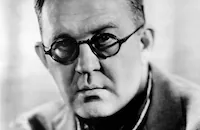The Plough and the Stars
Cast & Crew
John Ford
Barbara Stanwyck
Preston Foster
Barry Fitzgerald
Denis O'dea
Eileen Crowe
Film Details
Technical Specs

Synopsis
In the spring of 1916, a fever of rebellion against British rule spreads through the streets of Dublin. Fearful that her husband Jack will die fighting in the Irish cause, as her father did years before, Nora Clitheroe keeps secret from him the news that he has been made a commandant in the new Citizens' Army of Ireland. When Jack receives a message ordering him to report as a commandant to General Connolly, however, he chastises Nora for her selfishness and joins the army's torchlight procession and rally. During the rally, Nora commiserates with Mollser Gogan, the poor tubercular daughter of her upstairs neighbor, and explains with anguish that women are doomed to love, and men to fight. After the procession, Jack and the Irish army leaders meet to formalize their commitment and sign a declaration of Irish sovereignty. Later, while Nora and he enjoy a park outing, Jack is called away to another meeting, at which General Connolly announces plans to take control of a British-controlled post office. As a desperate battle between the poorly armed revolutionaries and the British army rages at the post office, hundreds of Dubliners begin looting stores and fighting among themselves. After Jack volunteers to run messages to the other commandants, he meets a frantic Nora on the battle-torn streets but refuses to return home with her. Before the fight is finished, Mollser dies and Nora is weakened with worry. The rebels, defeated at the post office, then take to the rooftops, where they hide and snipe at British soldiers. Hotly pursued, Jack scrambles over the rooftops and into the Gogan's flat. By hiding his rifle in Mollser's coffin, Jack avoids arrest and is reunited with Nora. As the British throw down the Irish "Plough and the Stars" flag from the post office roof, however, Jack vows to Nora that the fight for freedom will continue.

Director

John Ford
Cast

Barbara Stanwyck

Preston Foster

Barry Fitzgerald

Denis O'dea
Eileen Crowe
F. J. Mccormick

Una O'connor

Arthur Shields

Moroni Olsen

J. M. Kerrigan

Bonita Granville
Erin O'brien-moore
Neil Fitzgerald
Robert Homans

Brandon Hurst
Cyril Mclaglen

Wesley Barry
D'arcy Corrigan
Mary Gordon
Doris Gordon
Jack Pennick
Lionel Pape
Les Sketchley
Pat Hartigan
Wingate Smith
Francis Ford
Gaylord Pendleton
James Gordon
Pat O'malley
Harry Tenbrook
Frank Anthony
Larry Bubke
Jack Rice
Wheaton Chambers
Frank Benson
George Magrill
Duke Green
Charles Sedgwick
Mike Fitzmaurice
George Daly
Tommy Bupp
Frank Hagney
Billy Watson
Ernie Shields
Thomas Carr
Frank Moran
Ben Hall
Mat Harris
Flo Nix
Cecil Weston

Doris Lloyd
Colin Kenny
Ann Bupp
Crew
Joseph August
Samuel J. Briskin
Carroll Clark
D. A. Cutler
Edward Donahue
George Hively
Hugh Mcdowell Jr.
George Bernard Mcnulty
George Nicholls Jr.
Dudley Nichols
Van Nest Polglase
Cliff Reid
Arthur Shields
Darrell Silvera
Robert Sisk
Roy Webb

Film Details
Technical Specs

Quotes
Trivia
Notes
Sean O'Casey's name appears above the film's title. Barry Fitzgerald, Denis O'Dea, Eileen Crowe, F. J. McCormick and Arthur Shields, Fitzgerald's brother, (who is credited on the film as having "assisted" Ford in his direction), were Abbey Theatre players who had acted in O'Casey's long-running play in Dublin. All of the above cast members except Fitzgerald made their talking-picture debuts in this film. (The Plough and the Stars was Fitzgerald's first American film.) Una O'Connor and J. M. Kerrigan were former Abbey Theatre members. Eileen Crowe and F. J. McCormick were married at the time of this production. Studio publicity touted the film, which was the last film John Ford directed for RKO, as a natural successor to the successful 1935 film, The Informer. Ford, Dudley Nichols, George Bernard McNulty, Joseph August and Cliff Reid also worked together on The Informer. According to Hollywood Reporter, RKO wanted to borrow Spencer Tracy to play the Jack Clitheroe part, but M-G-M refused to loan the actor because they felt the part was not strong enough. Articles in New York Times give the following information about the production: Maureen Delaney of the Abbey Theatre was hired to appear in the film but did not make the trip to Hollywood. RKO wanted to borrow Pat O'Brien for the film but was turned down by Warner Bros. To avoid fire hazards during the battle sequences, Polglase's post office set, which was built entirely on an asbestos-lined sound stage, was mounted over a huge tank of water.
Modern sources give the following additional information about the production: As a trade-off for hiring the Abbey Theatre actors, the studio insisted that Barbara Stanwyck be cast in the lead. While Ford, who had fought with the studio to cast the Abbey Theatre actors, was on a post-production vacation, executive producer Samuel Briskin hired director George Nicholls, Jr. to reshoot certain scenes in the movie. The new scenes changed the relationship of the leads from husband and wife to boyfriend and girl friend. Although none of the trade reviewers mention this change and probably saw only the previously shot version, prints with this alteration were circulated in the United States. When Ford heard about the changes, he tried unsuccessfully to have his name removed from the credits. According to an interview with Ford, English and Irish distributors refused to show the altered version and only screened the original. The financial failure of the modestly budgeted film caused RKO to reassess its commitment to producing "prestige" films. Documentary footage of the actual Easter Rebellion was intercut into the film. Modern sources credit Nathaniel Shilkret as the music director and Walter Plunkett as costume designer. Additional cast members from modern sources include Mary Quinn and Frank Baker. Modern sources conflict in completing character names. In O'Casey's play, however, the Irish leaders are called Padraic Pearse and General Connolly.












